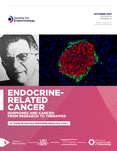De novo mutation in MEN1 is not associated with parental somatic mosaicism
- Yael Laitman1,
- Anat Jaffe2,
- Hagit Schayek1 and
- Eitan Friedman1,3⇑
- 1The Susanne Levy Gertner Oncogenetics Unit, Institute of Human Genetics, Chaim Sheba Medical Center, Tel-Hashomer, Israel
- 2Endocrinology and Diabetes Unit, Hillel Yaffe Medical Center, Hadera, Israel
- 3The Sackler School of Medicine, Tel-Aviv University, Tel-Aviv, Israel
- (Correspondence should be addressed to E Friedman; email: feitan{at}post.tau.ac.il or eitan.friedman{at}sheba.health.gov.il)
Dear Editor,
Multiple endocrine neoplasia type 1 (MEN1-OMIM #131100) is characterized by the co-occurrence of tumors in at least two of the following three endocrine tissues: parathyroid, endocrine pancreas and anterior pituitary (Thakker 2014). Familial MEN1 follows an autosomal dominant mode of inheritance, and germline mutations in the MEN1 gene at 11q13 can be detected in affected family members (Chandrasekharappa et al. 1997). Mutations in the CDKN1B gene (CDKN1B, KIP1 and OMIM #600778) have been also reported in MEN1 families but are far less frequent (Pellegata et al. 2006). Germline mutations in the MEN1 gene have also been detected in seemingly sporadic MEN1 cases and have been referred to as de novo mutations. Indeed, an often quoted number in MEN1-focused reports is 10% of the cases showing a de novo mutation (Bassett et al. 1998). The occurrence of a mutation in an affected individual with none of the parents exhibiting MEN1-suggestive features may be attributed to non-paternity, non-penetrant mutant allele, gonadal mosaicism or parental germline/somatic mosaicism (Koper & Lamberts 2000). The assignment of a de novo MEN1 gene mutation in previous studies was based on lack of a parental phenotype (Peppa et al. 2009), inferred haplotype (Bassett et al. 1998) or lack of the proband’s mutation in either parent using Sanger sequencing (Teh et al. 1998, Rix et al. 2004). No published study used deep sequencing to assess the possibility of parental, low-level mosaicism.
The diagnostic criteria of MEN1 include having at least two of the three predominant neoplasms in at least one case (Thakker 2014). Clinical associations …












